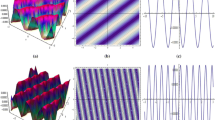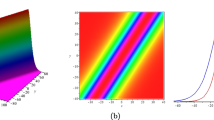Abstract
Under investigation in this paper is a generalized (3 + 1)-dimensional variable-coefficient BKP equation, which can be used to describe the propagation of nonlinear waves in fluid mechanics and other fields. With the aid of binary Bell’s polynomials, an effective and straightforward method is presented to explicitly construct its bilinear representation with an auxiliary variable. Based on the bilinear formalism, the soliton solutions and multi-periodic wave solutions are well constructed. Furthermore, the tanh method and the tan method are employed to construct more traveling wave solutions of the equation. Finally, the asymptotic properties of the multi-periodic wave solutions are systematically analyzed to reveal the connection between periodic wave solutions and soliton solutions. It is interesting that the periodic waves tend to solitary waves under a limiting procedure. Our results can be used to enrich the dynamical behavior of higher-dimensional nonlinear wave fields.





Similar content being viewed by others
References
Ablowitz, M.J., Clarkson, P.A.: Solitons; Nonlinear Evolution Equations and Inverse Scattering. Cambridge University Press, Cambridge (1991)
Bluman, G.W., Kumei, S.: Symmetries and Differential Equations. Graduate Texts in Mathematics, vol. 81. Springer, New York (1989)
Hirota, R.: Direct Methods in Soliton Theory. Springer, Berlin (2004)
Matveev, V.B., Salle, M.A.: Darboux Transformation and Solitons. Springer, Berlin (1991)
Wazwaz, A.M.: The tanh method for travelling wave solutions of nonlinear equations. Appl. Math. Comput. 154(3), 713–723 (2004)
Wazwaz, A.M.: Partial Differential Equations: Methods and Applications. Balkema Publishers, Rotterdam (2002)
Hu, X.B., Li, C.X., Nimmo, J.J.C., Yu, G.F.: An integrable symmetric (2 + 1)-dimensional Lotka–Volterra equation and a family of its solutions. J. Phys. A Math. Gen. 38, 195–204 (2005)
Zhang, D.J., Chen, D.Y.: Some general formulas in the Sato’s theory. J. Phys. Soc. Jpn. 72(2), 448–449 (2003)
Ma, W.X., You, Y.C.: Solving the Korteweg–de Vries equation by its bilinear form: Wronskian solutions. Trans. Am. Math. Soc. 357, 1753–1778 (2005)
Tian, B., Gao, Y.T.: Variable-coefficient higher-order nonlinear Schrödinger model in optical fibers: new transformation with burstons, brightons and symbolic computation. Phys. Lett. A 359, 241–248 (2006)
Wazwaz, A.M.: Multiple-soliton solutions and multiplesingular soliton solutions for two higher-dimensional shallow water wave equations. Appl. Math. Comput. 211, 495–501 (2009)
Wazwaz, A.M.: Multiple soliton solutions and multiple singular soliton solutions for the (3 + 1)-dimensional Burgers equations. Appl. Math. Comput. 204, 942–948 (2008)
Biswas, A.: Solitary wave solution for KdV equation with power-law nonlinearity and time-dependent coefficients. Nonlinear Dyn. 58(1–2), 345–348 (2009)
Feng, L.L., Tian, S.F., Wang, X.B., Zhang, T.T.: Rogue waves, homoclinic breather waves and soliton waves for the (2 + 1)-dimensional B-type Kadomtsev–Petviashvili equation. Appl. Math. Lett. 65, 90–97 (2017)
Wang, G.W., Xu, T.Z., Johnson, S., Biswas, A.: Solitons and Lie group analysis to an extended quantum Zakharov-Kuznetsov equation. Astrophys Space Sci 349, 317–327 (2014)
Wang, G.W., Xu, T.Z., Ebadi, G., Johnson, S., Strong, A.J., Biswas, A.: Singular solitons, shock waves, and other solutions to potential KdV equation. Nonlinear Dyn. 76, 1059–1068 (2014)
Zhang, Y., Song, Y., Cheng, L., Ge, J.Y., Wei, W.W.: Exact solutions and Painlev analysis of a new (2 + 1)-dimensional generalized KdV equation. Nonlinear Dyn. 68, 445–458 (2012)
Guo, R., Hao, H.Q., Zhang, L.L.: Dynamic behaviors of the breather solutions for the AB system in fluid mechanics. Nonlinear Dyn. 74, 701–709 (2013)
Guo, R., Hao, H.Q.: Breathers and localized solitons for the Hirota–Maxwell–Bloch system on constant backgrounds in erbium doped fibers. Ann. Phys. 344, 10–16 (2014)
Wang, L., Zhang, J.H., Wang, Z.Q., Liu, C., Li, M., Qi, F.H., Guo, R.: Breather-to-soliton transitions, nonlinear wave interactions, and modulational instability in a higher-order generalized nonlinear Schrödinger equation. Phys. Rev. E 93, 012214 (2016)
Wang, L., Gao, Y.T., Meng, D.X., Gai, X.L., Xu, P.B.: Soliton-shape-preserving and soliton-complex interactions for a (1 + 1)-dimensional nonlinear dispersive-wave system in shallow water. Nonlinear Dyn. 66, 161–168 (2011)
Tian, S.F.: Initial-boundary value problems for the general coupled nonlinear Schrödinger equation on the interval via the Fokas method. J. Differ. Equ. 262, 506–558 (2017)
Wang, X.B., Tian, S.F., Xu, M.J., Zhang, T.T.: On integrability and quasi-periodic wave solutions to a (3 + 1)-dimensional generalized KdV-like model equation. Appl. Math. Comput. 283, 216–233 (2016)
Tian, S.F.: The mixed coupled nonlinear Schrödinger equation on the half-line via the Fokas method. Proc. R. Soc. Lond. A 472, 20160588(22pp) (2016)
Xu, M.J., Tian, S.F., Tu, J.M., Ma, P.L., Zhang, T.T.: On quasiperiodic wave solutions and integrability to a generalized (2 + 1)-dimensional Korteweg–de Vries equation. Nonlinear Dyn. 82, 2031–2049 (2015)
Tu, J.M., Tian, S.F., Xu, M.J., Song, X.Q., Zhang, T.T.: Bäcklund transformation, infinite conservation laws and periodic wave solutions of a generalized (3 + 1)-dimensional nonlinear wave in liquid with gas bubbles. Nonlinear Dyn. 83, 1199–1215 (2016)
Tian, S.F., Ma, P.L.: On the quasi-periodic wave solutions and asymptotic analysis to a (3 + 1)-dimensional generalized Kadomtsev–Petviashvili equation. Commun. Theor. Phys. 62, 245 (2014)
Xu, M.J., Tian, S.F., Tu, J.M., Zhang, T.T.: Bäcklund transformation, infinite conservation laws and periodic wave solutions to a generalized (2 + 1)-dimensional Boussinesq equation. Nonlinear Anal. 31, 388–408 (2016)
Nakamura, A.: A direct method of calculating periodic wave solutions to nonlinear evolution equations. Exact one and two-periodic wave solution of the coupled bilinear equations. J. Phys. Soc. Jpn. 48, 1701–1705 (1980)
Bell, E.T.: Exponential polynomials. Ann. Math. 35, 258–277 (1834)
Gilson, C., Lambert, F., Nimmo, J.J.C.: On the combinatorics of the Hirota \(D\)-operators. Proc. R. Soc. Lond. A 452, 223–234 (1996)
Lambert, F., Springael, J., Willox, R.: Construction of Bäcklund transformations with binary Bell polynomials. J. Phys. Soc. Jpn. 66, 2211–2213 (1997)
Fan, E.G., Hon, Y.C.: On a direct procedure for the quasi-periodic wave solutions of the supersymmetric Ito is equation. Rep. Math. Phys. 66, 355–365 (2010)
Fan, E.G., Hon, Y.C.: A kind of explicit quasi-periodic solution and its limit for the Toda lattice equation. Mod. Phys. Lett. 22, 547–553 (2008)
Fan, E.G., Hon, Y.C.: Super extension of Bell polynomials with applications to supersymmetric equations. J. Math. Phys. 53, 013503 (2012)
Demiray, S., Tascan, F.: Quasi-periodic solutions of (3 + 1) generalized BKP equation by using Riemann theta functions. Appl. Math. Comput. 273, 131–141 (2016)
Ma, W.X., Fan, E.G.: Linear superposition principle applying to Hirota bilinear equations. Comput. Math. Appl. 61, 950–959 (2011)
Ma, W.X., Zhou, R.G., Gao, L.: Exact one-periodic and two-periodic wave solutions to Hirota bilinear equations in (2 + 1) dimensions. Mod. Phys. Lett. A 24, 1677–1688 (2009)
Ma, W.X.: Trilinear equations, Bell polynomials, and resonant solutions. Front. Math. China 8(5), 1139–1156 (2013)
Chow, K.W.: A class of exact, periodic solutions of nonlinear envelope equations. J. Math. Phys. 36, 4125–4137 (1995)
Wang, Y., Chen, Y.: Binary Bell polynomial manipulations on the integrability of a generalized (2 + 1)-dimensional Korteweg–de Vries equation. J. Math. Anal. Appl. 400, 624–634 (2013)
Miao, Q., Wang, Y.H., Chen, Y., Yang, Y.Q.: PDE Bell II A Maple package for finding bilinear forms, bilinear Bäcklund transformations, Lax pairs and conservation laws of the KdV-type equations. Comput. Phys. Commun. 185, 357–367 (2014)
Tian, S.F., Zhang, H.Q.: Riemann theta functions periodic wave solutions and rational characteristics for the nonlinear equations. J. Math. Anal. Appl. 371, 585–608 (2010)
Tian, S.F., Zhang, H.Q.: A kind of explicit Riemann theta functions periodic waves solutions for discrete soliton equations. Commun. Nonlinear Sci. Numer. Simul. 16, 173–186 (2011)
Tian, S.F., Zhang, H.Q.: On the integrability of a generalized variable-coefficient Kadomtsev–Petviashvili equation. J. Phys. A Math. Theor. 45, 055203 (29pp) (2012)
Tian, S.F., Zhang, H.Q.: On the integrability of a generalized variable-coefficient forced Korteweg–de Vries equation in fluids. Stud. Appl. Math. 132, 212–246 (2014)
Tian, S.F., Zhang, H.Q.: Riemann theta functions periodic wave solutions and rational characteristics for the (1 + 1)-dimensional and (2+1)-dimensional Ito equation. Chaos Solitons Fractals 47, 27–41 (2013)
Abudiab, M., Khalique, C.M.: Exact solutions and conservation laws of a (3 + 1)-dimensional B-type Kadomtsev–Petviashvili equation. Adv. Differ. Equ. 2013, 221 (2013)
Wazwaz, A.M.: Two forms of (3 + 1)-dimensional B-type Kadomtsev–Petviashvili equation: multiple-soliton solutions. Phys. Scr. 86, 035007 (2012)
Acknowledgements
We express our sincere thanks to the Editors and Reviewers for their valuable comments. This work was supported by the Fundamental Research Fund for Talents Cultivation Project of the China University of Mining and Technology (Project No. YC150003).
Author information
Authors and Affiliations
Corresponding authors
Additional information
This work was supported by the Fundamental Research Fund for Talents Cultivation Project of the China University of Mining and Technology under the Grant No. YC150003.
Appendix: Riemann theta function periodic waves
Appendix: Riemann theta function periodic waves
In order to consider three-periodic wave solutions of Eq. (1). By taking \(N=3\), Riemann theta function takes the following form
in which \(n=(n_{1},n_{2},n_{3})^{T}\in Z^{3}\), \(\xi =(\xi _{1},\xi _{2},\xi _{3})\in C^{3}\), \(\xi _{i}=k_{i} x+l_{i}y+r_{i}z+{\mathcal {M}}_{i} t +\varepsilon _{i},(i=1,2,3)\). \(-i\tau \) is a positive-define and real-valued symmetric \(2\times 2\) matrix, which is of explicit form
in which \({\text {Im}}(\tau _{ij})>0\), \(i=j=1,2,3\).
Theorem 6.1
[43,44,45,46,47] Supposing that \(\vartheta (\xi _{1},\xi _{2},\xi _{3},\tau )\) is a multi-dimensional Riemann theta function as \(N=3\) and \(\xi _{i}=k_{i}x+l_{i}y+r_{i}z+{\mathcal {M}}_{i}t+\varepsilon _{i}\), then \(k_{i},l_{i},r_{i},{\mathcal {M}}_{i}(i=1,2,3)\) hold the following expressions
in which \(\theta _{i}=\left( \begin{array}{c} \theta _{i}^{1} \\ \theta _{i}^{2} \\ \theta _{i}^{3} \\ \end{array} \right) \) and \(\theta _{1}=\left( \begin{array}{c} 0 \\ 0 \\ 0 \\ \end{array} \right) \), \(\theta _{2}=\left( \begin{array}{c} 0 \\ 0 \\ 1 \\ \end{array} \right) \), \(\theta _{3}=\left( \begin{array}{c} 0 \\ 1 \\ 0 \\ \end{array} \right) \), \(\theta _{4}=\left( \begin{array}{c} 0 \\ 1 \\ 1 \\ \end{array} \right) \), \(\theta _{5}=\left( \begin{array}{c} 1 \\ 0 \\ 0 \\ \end{array} \right) \), \(\theta _{6}=\left( \begin{array}{c} 1 \\ 0 \\ 1 \\ \end{array} \right) \), \(\theta _{7}=\left( \begin{array}{c} 1 \\ 1 \\ 0 \\ \end{array} \right) \), \(\theta _{8}=\left( \begin{array}{c} 1 \\ 1 \\ 1 \\ \end{array} \right) \), \(i=1,2,3,\dots ,8\).
According to the above Theorem 6.1 and Eq. (18), the parameters \(k_{i},l_{i},r_{i},{\mathcal {M}}_{i}\) should provide the following expressions
The above equation can be written in a new form
where
We solve the above system and we can obtain the three-periodic wave solution as
in which \(\vartheta (\xi _{1},\xi _{2},\xi _{3},\tau )\) and \(({\mathcal {M}}_{1},{\mathcal {M}}_{2},{\mathcal {M}}_{3},u_{0},{\mathcal {C}})^{T}\) are known by (59). The other parameters \(k_{i},l_{i},r_{i},\varepsilon _{i},\tau _{ij}(i,j=1,2,3)\) are free.
Summing up the above analysis for the three-periodic wave solution, the following assertion is constructed.
Theorem 6.2
Supposing that \(\vartheta (\xi _{1},\xi _{2},\xi _{3},\tau )\) is a Riemann theta function with \(N=3\) and \(\xi _{i}=k_{i}x+l_{i}y+r_{i}z+{\mathcal {M}}_{i}t+\varepsilon _{i}(i=1,2,3)\). The VC-BKP equation (i.e., Eq. (1)) admits a three-periodic wave solution as follows
where \(u_{0}\) and \(\vartheta (\xi _{1},\xi _{2},\xi _{3},\tau )\) fulfill the expression (63) and (63). In addition, \(\theta _{i}=\left( \begin{array}{c} \theta _{i}^{1} \\ \theta _{i}^{2} \\ \theta _{i}^{3} \\ \end{array} \right) \) and, \(\theta _{i_{1}}^{1}=0\), \(\theta _{j_{1}}^{1}=1\), with \(i_{1}=1,2,3,4,j_{1}=5,6,7,8\), \(\theta _{i_{2}}^{2}=0\), \(\theta _{j_{2}}^{2}=1\), with \(i_{2}=1,2,5,6,j_{2}=3,4,7,8\), \(\theta _{i_{3}}^{3}=0\), \(\theta _{j_{3}}^{3}=1\), with \(i_{3}=1,3,5,7,j_{2}=2,4,6,8\). The other parameters \(k_{i},l_{i},r_{i},\varepsilon _{i},\tau _{ij}(i,j=1,2,3)\) are arbitrary parameters.
Rights and permissions
About this article
Cite this article
Wang, XB., Tian, SF., Feng, LL. et al. Quasiperiodic waves, solitary waves and asymptotic properties for a generalized (3 + 1)-dimensional variable-coefficient B-type Kadomtsev–Petviashvili equation. Nonlinear Dyn 88, 2265–2279 (2017). https://doi.org/10.1007/s11071-017-3375-7
Received:
Accepted:
Published:
Issue Date:
DOI: https://doi.org/10.1007/s11071-017-3375-7




